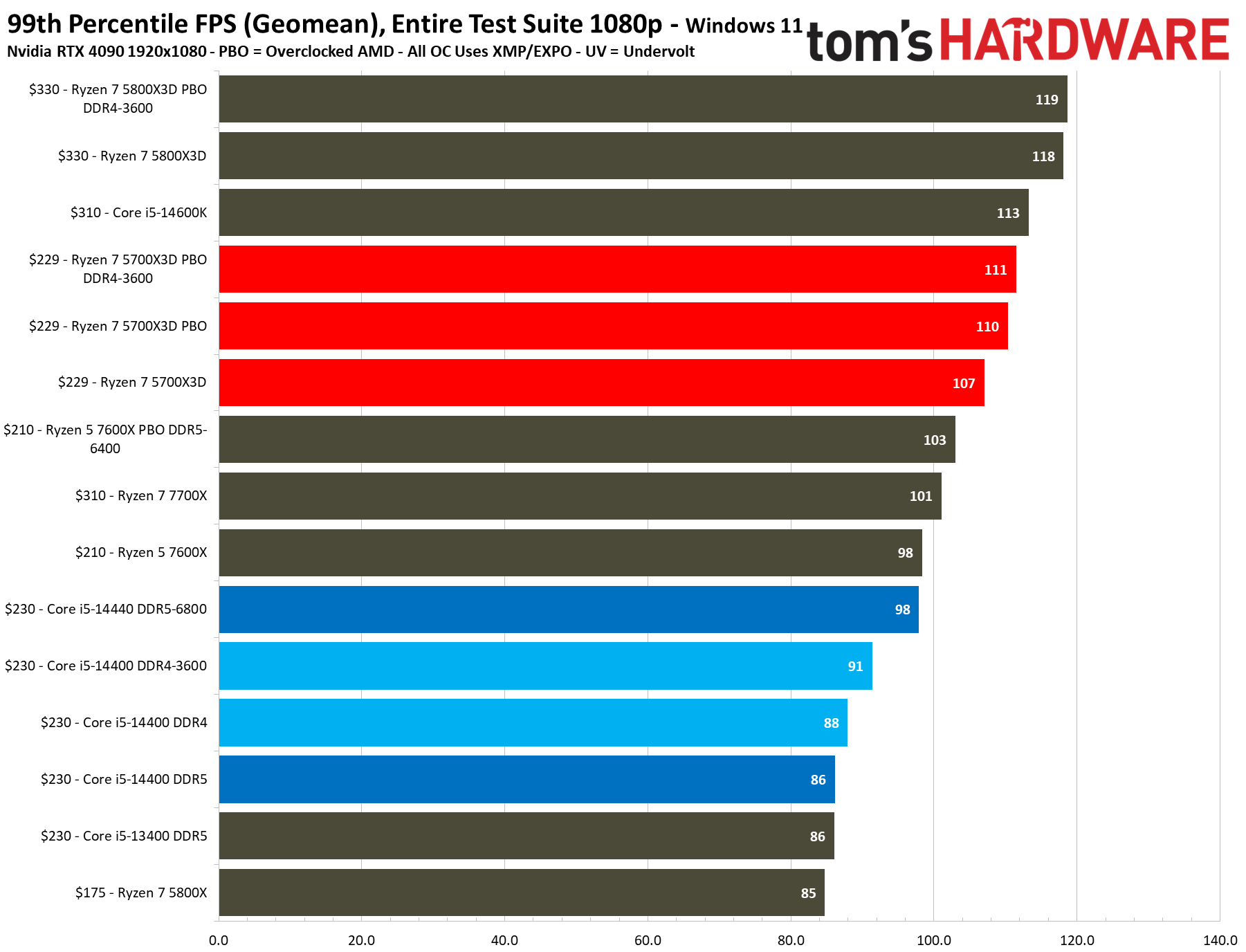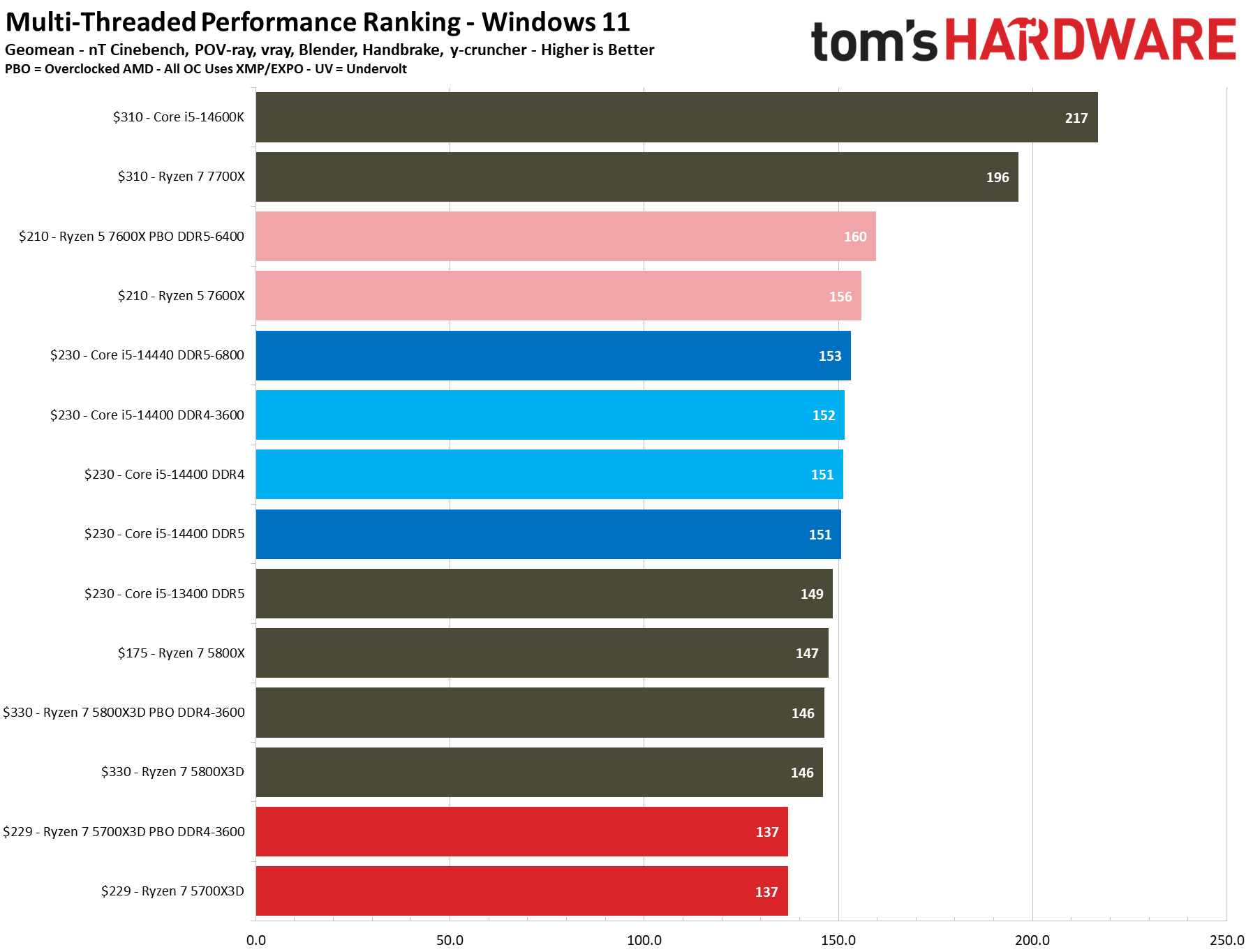Why you can trust Tom's Hardware
The $229 Ryzen 5 5700X3D earns a spot on our Best CPUs for gaming list due to its exceptional gaming performance at its price point. This chip is suitable both as a budget-class option for a new build that leverages the affordable and plentiful AM4 and DDR4 ecosystem or as a budget upgrade to an existing AM4 build.
As we've shown, the Intel Core i5-14400 can't compete with the reduced pricing of the modern Ryzen 5 7000-series models, but the Ryzen 7 5700X3D pressures Intel's lineup from the other end of the spectrum. This chip builds on the success of the company's X3D cache technology to deliver a stunning amount of gaming performance despite its prior-gen Zen 3 architecture, but it does come with some tradeoffs in application performance. In either case, it's a win for AM4 upgraders and those solely interested in gaming.
Below, we have the geometric mean of our gaming test suite at 1080p and 1440p and a cumulative measure of performance in single- and multi-threaded applications. We conducted our gaming tests with an Nvidia RTX 4090, so performance deltas will shrink with lesser cards and higher resolution and fidelity settings.






The Ryzen 7 5700X3D is optimized for gaming, but the 3D V-Cache tech results in lower clock speeds that hamstring performance in productivity applications. The chip also leverages the previous-gen Zen 3 architecture, so application performance is particularly lackluster compared to newer Ryzen 7000 and Intel chips. But it's killer in gaming. At this price point, the Core i5-14400 or the Ryzen 5 7600X are the competing options if you're looking for a balanced level of both gaming and productivity performance.
The $229 Ryzen 7 5700X3D is a whopping 30% faster than the $230 Core i5-14400 in gaming. However, the 14400 is 10% faster in multi-threaded work and 27% faster in single-threaded applications, offering a much more balanced profile.
The Ryzen 7 5700X3D is 13% faster at 1080p gaming than the $210 Ryzen 5 7600X at stock settings, but the 7600X is 14% faster in multi-threaded and 37% faster in single-threaded workloads. You'll have to step up to an AM5 platform to use the 7600X, which adds quite a bit of cost over the affordable and plentiful AM4 ecosystem.
If you're choosing between the Ryzen 5 7600X and the Core i5-14400, the AMD chip is a better value. The 7600X is 14% faster than the Core i5-14400 in 1080p gaming and is also solid in our productivity test suite — it's 6% faster than the Core i5-14400 in single-threaded work and 3% faster in multi-threaded applications. That makes it a good all-rounder alternative if you prize performance in productivity workloads. You can also opt for the Ryzen 5 7600, which weighs in at $190 and offers about 3% less gaming performance than the 7600X.
Get Tom's Hardware's best news and in-depth reviews, straight to your inbox.
For the Ryzen 7 5700X3D and Ryzen 5 7600X, you'll need to buy your own cooler, but these chips aren't difficult to cool with budget-class coolers. If you're upgrading an AM4 platform with the 5700X3D, there's a good chance that your existing cooler will be fine, particularly if it is an AIO. The Core i5-14400 comes with a 'free' bundled cooler, but we advise purchasing a ~$25 tower air cooler instead of using the stock cooler.
One of the Ryzen 5 5700XD’s greatest advantages is AMD’s AM4 socket. This motherboard platform has soldiered on since 2017, housing five CPU generations spanning 125+ processors and over 500 different motherboard designs, and it is truly the gift that keeps on giving with the Ryzen 5 5700X3D. This platform is plentiful and cheap, so it makes a great palette for budget gaming builds.
The Ryzen 5 5700X3D doesn’t officially support overclocking the CPU cores or adjusting the CPU voltages. Unofficial workarounds do exist, but they are risky. You can fully overclock both the memory and fabric, but this results in meager performance gains. That isn't a totally bad thing—you get the lion's share of peak performance with minimal fuss.
If you have the extra cash, the Ryzen 7 5800X3D remains the king of the hill for either new or upgraded AM4 systems that are focused on gaming performance. However, you can save $81 (35%) while getting 91% of the 5800X3D's gaming performance with the Ryzen 7 5700X3D, which is a solid value. If you're only interested in gaming, particularly for AM4 upgraders, the Ryzen 7 5700X3D is the go-to chip for budget gaming builds.
- MORE: AMD vs Intel
- MORE: Zen 4 Ryzen 7000 All We Know
- MORE: Raptor Lake All We Know
Current page: 500+ motherboardd designs later, and AM4's still kicking
Prev Page AMD Ryzen 7 5700X3D Power Consumption, Overclocking, Test Setup
Paul Alcorn is the Editor-in-Chief for Tom's Hardware US. He also writes news and reviews on CPUs, storage, and enterprise hardware.
-
Avro Arrow The R7-5700X3D is TOTALLY what AM4 gamers should upgrade to before changing platforms. The only reason that I have an R7-5800X3D is that, when I bought it, it was on sale for $100CAD off and the R7-5700X3D didn't yet exist.Reply
The weird thing about AM4 is that, while it was released in 2016, the first AM4 motherboards weren't released until February of 2017. So technically, it's almost 8 years old but functionally, it just turned 7 last month.
I guess that it took about five months for the AIBs to get the motherboards made. -
parkerthon Reply
I just am amazed we’re at this point that builds can make it so many years for a gaming PC. Things have definitely changed in the last decade. It’s nice to be able to build something that has legs for 5+ years. Then swap a gpu, maybe add new ssd or more memory, and get three more.Avro Arrow said:The R7-5700X3D is TOTALLY what AM4 gamers should upgrade to before changing platforms. The only reason that I have an R7-5800X3D is that, when I bought it, it was on sale for $100CAD off and the R7-5700X3D didn't yet exist.
The weird thing about AM4 is that, while it was released in 2016, the first AM4 motherboards weren't released until February of 2017. So technically, it's almost 8 years old but functionally, it just turned 7 last month. -
Avro Arrow Reply
It's because hardware development has outpaced software development for some time now. There's also the fact that some of the most popular games in the world are also some of the least hardware-intensive.parkerthon said:I just am amazed we’re at this point that builds can make it so many years for a gaming PC. Things have definitely changed in the last decade. It’s nice to be able to build something that has legs for 5+ years. Then swap a gpu, maybe add new ssd or more memory, and get three more.
You could probably still play games like WoW, LoL, Overwatch, CS:GO and Apex Legends with an old i7-2600K or FX-8350 CPU coupled with an old R9 Fury or GTX 980. -
strobolt ReplyThe Core i5-14400 comes with a 'free' bundled cooler, but we advise purchasing a ~$25 tower air cooler instead of using the stock cooler.
This came up also in the 14400 review thread but went a bit unanswered so I'm asking again: why is it advised to get an aftermarket cooler?
Would be interesting to see some real world data on this in addition to the "this is the generally accepted point-of-view". To me it's not even about the cost (which is trivial anyway) but the fact that you're just throwing away a perfectly fine cooler "just because". At least I've not seen any test setup where the 14400 would've throttled with stock cooler. Also I doubt the overall noise level is that much higher either when considering that you're also running a GPU with that. -
35below0 Reply
Agreed. An aftermarket cooler is superior for sure, but also unneccessary.strobolt said:This came up also in the 14400 review thread but went a bit unanswered so I'm asking again: why is it advised to get an aftermarket cooler?
Would be interesting to see some real world data on this in addition to the "this is the generally accepted point-of-view". To me it's not even about the cost (which is trivial anyway) but the fact that you're just throwing away a perfectly fine cooler "just because". At least I've not seen any test setup where the 14400 would've throttled with stock cooler. Also I doubt the overall noise level is that much higher either when considering that you're also running a GPU with that.
That said, AMD's stock coolers have improved in recent years. Intel not so much. It's good enough i guess.
For any more powerfull intel, it would be better to use an aftermarket cooler, K or not. For fan noise if nothing else.
Noise may be irrelevant when GPU fans kick in, but not when they're stopped and the CPU is working hard on something non gaming related.
But there is a hidden penalty to tower air coolers. If your PC case is going to be moved, or bounced around in a car, you have to take off the cooler or risk damaging the motherboard. With intel stock cooler, there is no chance of damage.
14400 may benefit slightly from a better cooler but not much. -
Notton Reply
Stock intel coolers are not "perfectly fine". They are loud and no amount of fan tuning helps quiet them down.strobolt said:This came up also in the 14400 review thread but went a bit unanswered so I'm asking again: why is it advised to get an aftermarket cooler?
Would be interesting to see some real world data on this in addition to the "this is the generally accepted point-of-view". To me it's not even about the cost (which is trivial anyway) but the fact that you're just throwing away a perfectly fine cooler "just because". At least I've not seen any test setup where the 14400 would've throttled with stock cooler. Also I doubt the overall noise level is that much higher either when considering that you're also running a GPU with that.
If you spend $25ish for a cheap tower heatsink the system will run quieter and cooler.
It's actually been a bit of a mystery to me why Intel insists on using those obnoxiously loud fans for over a decade. -
Amdlova Reply
Never is too late :) "AMD want you buy AM5" they don't send to people to test these cheap units, some one need to buy to testHideOut said:This th ing has been out since the end of January. The review is a bit late...
